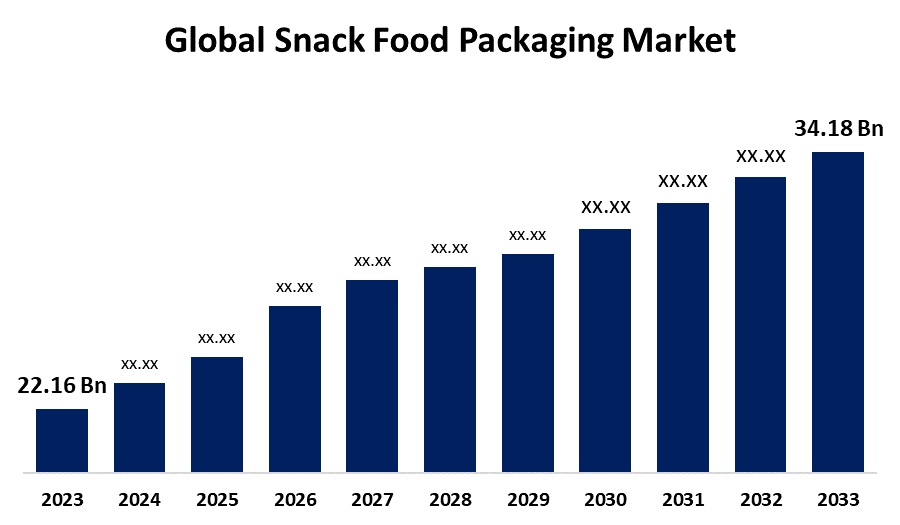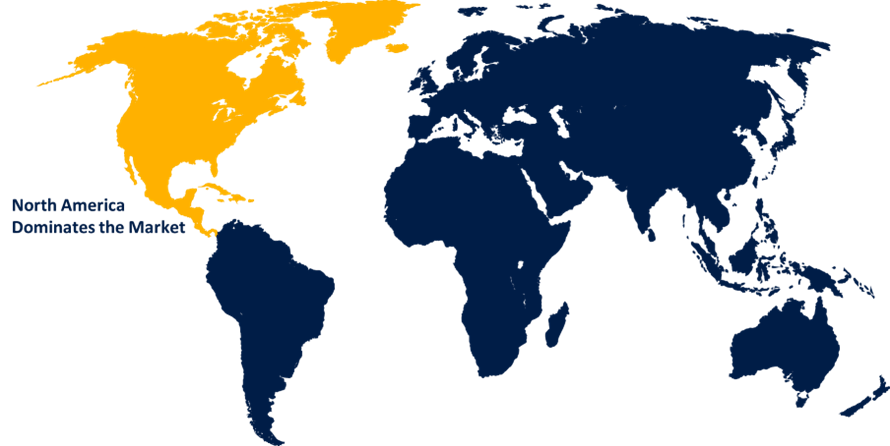Global Snack Food Packaging Market Size, Share, and COVID-19 Impact Analysis, By Material (Plastic, Paper, Metal, Glass, and Others), By Application (Wafers, Nuts & Dry Fruits, Baby Food, Ready-to-Eat Food, and Others), and By Region (North America, Europe, Asia-Pacific, Latin America, Middle East, and Africa), Analysis and Forecast 2023 - 2033
Industry: Food & BeveragesGlobal Snack Food Packaging Market Insights Forecasts to 2033
- The Global Snack Food Packaging Market Size was Valued at USD 22.16 Billion in 2023
- The Market Size is Growing at a CAGR of 4.43% from 2023 to 2033
- The Worldwide Snack Food Packaging Size is Expected to Reach USD 34.18 Billion by 2033
- Asia-Pacific is Expected to Grow the fastest during the forecast period.

Get more details on this report -
The Global Snack Food Packaging Market Size is Anticipated to Exceed USD 34.18 Billion by 2033, Growing at a CAGR of 4.43% from 2023 to 2033. Health-conscious consumers have created a need for snack packaging that emphasizes nutritional information and quantity control.
Market Overview:
Snack food packaging is a sort of packaging specifically designed to store, protect, and market a wide range of snacks such as chips, nuts, sweets, and cookies. Its key duties include keeping products fresh, increasing shelf life, and ensuring the overall quality and safety of the products. Snack food packaging materials range from flexible bags and pouches to rigid containers and cartons.
The development of snack food packaging materials is intended to fulfill the sector's packaging needs. The expansion of e-commerce is essentially driving the market for snack food packaging. The snack food packaging industry is in tremendous demand, with alterations in global dietary trends and a good outlook for discretionary personal spending driving growth. Fresh packaging options have also emerged due to the expanding assortment of commodities supplied in single-sized servings.
Opportunity:
The transition to environmentally friendly materials and methods is admirable, it frequently results in increased manufacturing costs. Sustainable resources, such as biodegradable plastics or recycled paper, might be more expensive than traditional alternatives, affecting snack manufacturers' profit margins.
Report Coverage:
This research report categorizes the market for the global snack food packaging based on various segments and regions forecasts revenue growth and analyses trends in each submarket. The report analyses the key growth drivers, opportunities, and challenges influencing the global snack food packaging market. Recent market developments and competitive strategies such as expansion, product launch, and development, partnership, merger, and acquisition have been included to draw the competitive landscape in the market. The report strategically identifies and profiles the key market players and analyses their core competencies in each sub-segment of the global snack food packaging market.
Driving Factors:
Changing consumer habits and an increased emphasis on healthy eating have contributed considerably to the snack food packaging market's growth. Consumers are increasingly looking for simple, ready-to-eat snack options that meet their busy lifestyles. This transition has increased the demand for packaging solutions that provide mobility, convenience of use, and the preservation of snack freshness, hence increasing the snack packaging industry. Furthermore, the surge in health consciousness has altered snacking habits.
Restraining Factors:
Product shelf life and environmental considerations provide opposing difficulties for the snack food packaging industry. On the one hand, consumers want longer shelf lives for snacks to assure product freshness and prevent food waste.
Market Segmentation:
The global snack food packaging market share is classified into material and application.
- The plastic segment has the largest share of the market during the forecast period.
Based on the material, the global snack food packaging market is categorized into plastic, paper, metal, glass, and others. Among these, the plastic segment has the largest share of the market during the forecast period. It provides durability, versatility, and cost-effectiveness. To address environmental concerns, contemporary snack food packaging trends have emphasized the use of sustainable plastic materials such as bioplastics and recyclable choices. Furthermore, advances in plastic packaging include thinner, lighter designs that reduce material utilization and waste. Anti-microbial and barrier-enhancing coatings are increasingly becoming popular for keeping snacks fresh.
- The wafers segment holds the biggest share of the market over the forecast period.
Based on the application, the global snack food packaging market is categorized into wafers, nuts & dry fruits, baby food, ready-to-eat food, and others. Among these, the wafers segment holds the biggest share of the market over the forecast period. Wafers are thin, crispy sweets made up of many layers, often filled with cream or flavored coatings. Wafers are becoming more popular in the snack food packaging market for their portion control and ease. Single-serve packs and resealable choices are increasing in popularity as people want to consume food on the go. Furthermore, there is an increasing need for environmentally friendly wafer packaging, which reflects broader sustainability concerns.
Regional Segment Analysis of the Global Snack Food Packaging Market
- North America (U.S., Canada, Mexico)
- Europe (Germany, France, U.K., Italy, Spain, Rest of Europe)
- Asia-Pacific (China, Japan, India, Rest of APAC)
- South America (Brazil and the Rest of South America)
- The Middle East and Africa (UAE, South Africa, Rest of MEA)
North America is projected to hold the largest share of the global snack food packaging market over the forecast period.

Get more details on this report -
North America is projected to hold the largest share of the global snack food packaging market over the forecast period. North America's snack food packaging sector is seeing major trends. Health-conscious consumers are driving the demand for packaging that emphasizes nutritional information and quantity control. Eco-friendly and sustainable packaging options are becoming more popular as environmental concerns develop. Furthermore, there is a focus on new designs to boost brand visibility in a competitive market. Regulatory compliance and safety measures continue to influence packaging practices in the region.
Asia-Pacific region is also expected to fastest CAGR growth during the forecast period. The Asia-Pacific snack food packaging industry is characterized by numerous notable developments. Rapid urbanization and changing lifestyles are driving up demand for single-serve snack packaging. Consumers are also exhibiting a desire for healthier snacks, which has influenced packaging designs that emphasize nutrition and portion control.
Competitive Analysis:
The report offers the appropriate analysis of the key organizations/companies involved within the global snack food packaging market along with a comparative evaluation primarily based on their product offering, business overviews, geographic presence, enterprise strategies, segment market share, and SWOT analysis. The report also provides an elaborative analysis focusing on the current news and developments of the companies, which includes product development, innovations, joint ventures, partnerships, mergers & acquisitions, strategic alliances, and others. This allows for the evaluation of the overall competition within the market.
List of Key Companies:
- Huhtamaki Group
- Bemis Company, Inc.
- WestRock Company
- Constantia Flexibles Group
- ProAmpac Holdings, Inc.
- Winpak Ltd.
- Printpack, Inc.
- Ball Corporation
- Tetra Pak International S.A.
- DS Smith plc
- Amcor Limited
- Berry Global Group, Inc.
- Mondi Group
- Sealed Air Corporation
- Sonoco Products Company
- Saica Group
- Others
Key Market Developments:
- In June 2024, Saica Group, a leading packaging solutions company, and Mondelez, a fast-moving consumer goods maker, partnered to introduce a new paper-based product for multipacks in the confectionery, biscuits, and chocolate markets.
Key Target Audience
- Market Players
- Investors
- End-users
- Government Authorities
- Consulting And Research Firm
- Venture capitalists
- Value-Added Resellers (VARs)
Market Segment
This study forecasts revenue at global, regional, and country levels from 2020 to 2033. Spherical Insights has segmented the global snack food packaging market based on the below-mentioned segments:
Global Snack Food Packaging Market, By Material
- Plastic
- Paper
- Metal
- Glass
- Others
Global Snack Food Packaging Market, By Application
- Wafers
- Nuts & Dry Fruits
- Baby Food
- Ready-to-Eat Food
- Others
Global Snack Food Packaging Market, By Regional
- North America
- US
- Canada
- Mexico
- Europe
- Germany
- Uk
- France
- Italy
- Spain
- Russia
- Rest of Europe
- Asia Pacific
- China
- Japan
- India
- South Korea
- Australia
- Rest of Asia Pacific
- South America
- Brazil
- Argentina
- Rest of South America
- Middle East & Africa
- UAE
- Saudi Arabia
- Qatar
- South Africa
- Rest of the Middle East & Africa
Frequently Asked Questions (FAQ)
-
1. What is the CAGR of the global snack food packaging market over the forecast period?The global snack food packaging market size is expected to grow from USD 22.16 Billion in 2023 to USD 34.18 Billion by 2033, at a CAGR of 4.43 % during the forecast period 2023-2033.
-
2. Which region is expected to hold the highest share in the global snack food packaging market?North America is projected to hold the largest share of the global snack food packaging market over the forecast period.
-
3. Who are the top key players in the snack food packaging market?Huhtamaki Group, Bemis Company, Inc, WestRock Company, Constantia Flexibles Group, ProAmpac Holdings, Inc, Winpak Ltd, Printpack, Inc, Ball Corporation, Tetra Pak International S.A, DS Smith plc, Amcor Limited, Berry Global Group, Inc, Mondi Group, Sealed Air Corporation, Sonoco Products Company, Saica Group, and Others.
Need help to buy this report?